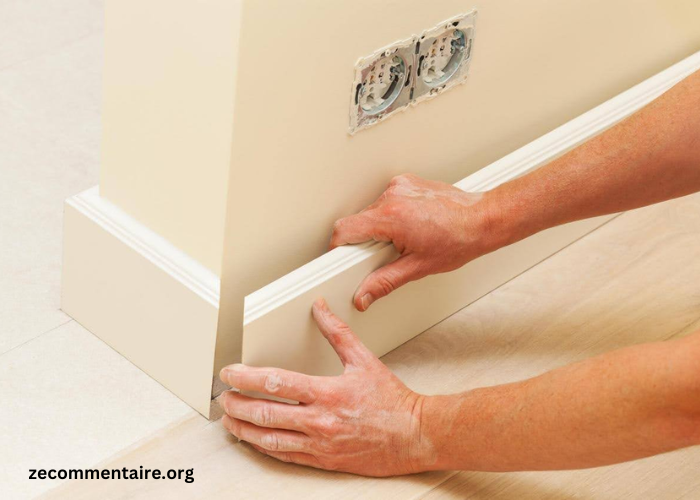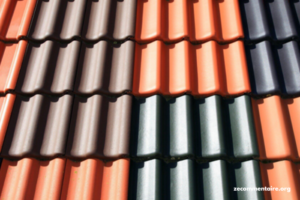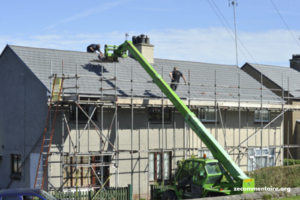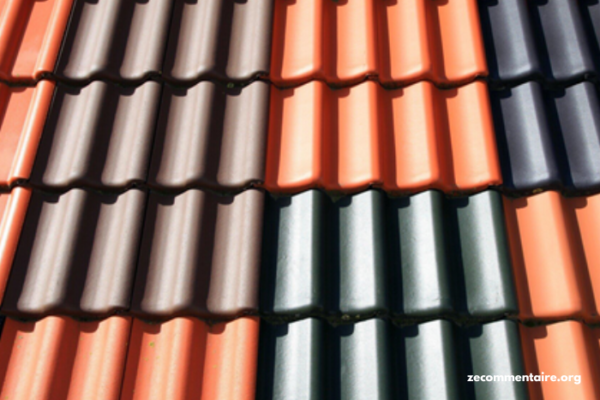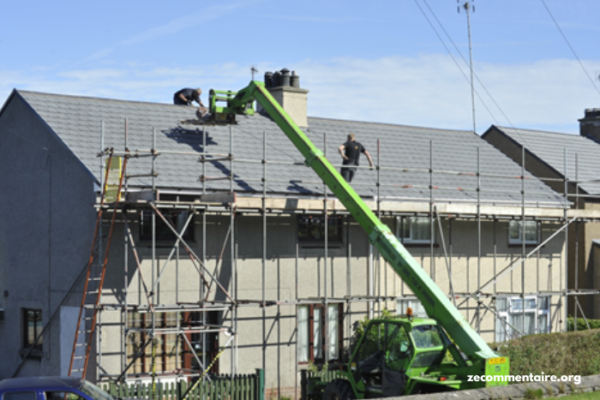Choosing the right wall material for your baseboards is crucial in achieving a seamless and polished look for your home. With numerous options available in the market, it can be overwhelming to decide which one best suits your needs. While some materials offer durability and low maintenance, others offer a sleek and modern appeal.
But with every decision comes a trade-off between the benefits and drawbacks. In this fast-paced world, making the right choice is vital, especially when it comes to your home.
That’s why we’ve researched for you to bring you a breakdown of the pros and cons of different types of wall materials for baseboards. Read on.
MDF (Medium Density Fiberboard)
When it comes to choosing the right wall material for baseboards, there are a few options available. One popular choice is medium-density fiberboard (MDF), a man-made material that is crafted from wood fibers and resin. However, it’s helpful to consult an expert for a baseboard installation tip to avoid any costly mistakes.
Pros:
MDF is one of the most cost-effective options available. It provides a high-quality look without breaking the bank. MDF offers a smooth surface that’s ideal for painting.
This makes it easy to match your baseboards with your wall color or other trim features. Unlike natural wood, MDF is less likely to warp or crack over time. It’s engineered to resist changes in temperature and humidity, ensuring longevity.
Cons:
MDF is highly susceptible to moisture damage. It’s not a suitable option for areas prone to dampness, like bathrooms or basements. While stable, MDF doesn’t offer the same durability as natural wood or other high-end materials.
It can dent or chip more easily. MDF is heavier than other materials, making installation more cumbersome. Cutting MDF can create fine dust particles, requiring appropriate safety measures.
Wood
Wood is a popular choice for baseboards due to its natural beauty and versatility. There are many types of wood baseboards to choose from.
Pros:
There’s nothing quite like the natural beauty of wood. It adds warmth and character to any room, making it a popular choice for traditional and modern homes alike.
From oak to pine, the range of wood types available means you can find something to suit your style and budget. Wooden baseboards can be easily stained, painted, or carved to meet your specific design needs.
Cons:
High-quality wood can be expensive. While there are budget-friendly options, they may not offer the same durability and aesthetic appeal.
Wood requires regular maintenance to keep it looking its best. This can include periodic staining, painting, or sealing. Wood can be prone to warping, cracking, or insect damage if not properly treated and maintained.
PVC (Polyvinyl Chloride)
PVC Polyvinyl Chloride has become a popular material for baseboards due to its low cost and durability. This type of baseboard can provide benefits but also has challenges.
Pros:
PVC is highly resistant to moisture, making it an excellent choice for areas like bathrooms, kitchens, and basements. PVC baseboards are tough and resistant to dents, scratches, and impacts. They’re ideal for high-traffic areas and homes with pets or children.
Unlike wood, PVC doesn’t require painting or sealing. It’s easy to clean and maintain, saving you time and effort.
Cons:
While modern PVC baseboards can mimic the look of wood, they often lack the genuine warmth and character of natural materials. High-quality PVC can be more expensive than MDF. However, its durability and low maintenance needs can offset initial costs over time.
PVC is a type of plastic, raising concerns about its environmental impact. Choosing recyclable options can help mitigate this issue.
Polystyrene
Polystyrene is a popular material for baseboards due to its affordability, durability, and versatility. However, this material also has its own set of pros and cons.
Pros:
Polystyrene baseboards are incredibly light, making them easy to transport and install. This material is often less expensive than wood or PVC, providing a budget-friendly option. Similar to PVC, polystyrene is resistant to mold and moisture, making it suitable for various environments.
Cons:
Polystyrene is not as durable as wood or PVC. It’s more prone to dents and scratches, which may require frequent repairs or replacements.
While functional, polystyrene baseboards may not offer the same high-end appearance as wood or even some PVC options. Polystyrene can be sensitive to certain chemicals and solvents, limiting your choices for cleaning products.
Hardwood
Hardwood is a popular and versatile option for baseboards, but like any other material, it has its pros and cons. On the positive side, hardwood is known for its durability and beauty.
Pros:
Hardwood baseboards are incredibly durable. They can withstand significant wear and tear, making them a long-lasting choice for any home.
The rich, natural beauty of hardwood can enhance any room’s décor. It’s often considered a premium option, adding value to your home. From mahogany to cherry, hardwoods come in a range of types, each offering unique colors and grain patterns.
Cons:
Hardwood is one of the most expensive options. However, its durability and aesthetic appeal can justify the higher upfront cost.
Like all wood, hardwood requires regular maintenance to prevent damage from moisture, insects, and wear. Hardwood is heavy, making installation more labor-intensive compared to lighter materials like MDF or polystyrene.
Metal (Aluminum or Stainless Steel)
When it comes to baseboards, metal materials such as aluminum and stainless steel have their unique pros and cons. The decision between aluminum or stainless steel for baseboards will depend on personal preference and budget.
Pros:
Metal baseboards offer a sleek, contemporary look that’s perfect for modern or industrial-style homes. Metal is incredibly durable and resistant to dents, scratches, and impacts.
It’s also impervious to moisture and pests. Metal baseboards are easy to clean and require minimal maintenance, retaining their appearance over time.
Cons:
Metal baseboards can be expensive. The cost of materials and installation can be higher than traditional options like wood or MDF.
While metal offers a modern appeal, it may not be suitable for all interior design styles. It can look out of place in more traditional or rustic settings. Metal requires specialized tools and techniques for installation, which can add to the overall cost and complexity.
Composite (WPC – Wood Plastic Composite)
Composite WPC (Wood Plastic Composite) is a versatile wall material that is gaining popularity in the construction industry. It is a combination of wood fibers and plastic materials, creating a strong and durable baseboard.
Pros:
WPC combines the best of both worlds-wood and plastic. It’s highly durable and resistant to moisture, pests, and impact.
Composite baseboards require minimal maintenance. They don’t need painting or sealing and are easy to clean. Many composites are made from recycled materials, offering a more sustainable choice for environmentally-conscious homeowners.
Cons:
High-quality composite baseboards can be more expensive than traditional wood or MDF options. While composites can mimic the look of wood, they may not offer the same natural warmth and character. Composite materials can expand and contract with temperature changes, potentially causing gaps or warping if not installed correctly.
Tile Baseboards
Tile baseboards can be an attractive and durable option for homeowners looking to enhance their walls. They offer a wide range of design options and are relatively easy to maintain. However, like any material, they also have their pros and cons.
Pros:
Tile baseboards are impervious to moisture, making them ideal for bathrooms, kitchens, and other wet areas. Tiles are incredibly durable and resistant to scratches, dents, and impacts. They can withstand heavy foot traffic and are easy to clean.
Tiles come in a wide range of colors, patterns, and textures. It allows for creative and customized designs.
Cons:
Tile baseboards can be expensive, both in terms of material and installation costs. The complexity of laying tiles can add to the overall expense.
Tiles can feel cold to the touch, which may not be desirable in all living spaces, especially in colder climates. Installing tile baseboards is a labor-intensive process that requires precision and time. Mistakes can be costly to fix
Rubber Baseboards
Rubber baseboards have become a popular choice for baseboard materials due to their durability and flexibility. The decision to use rubber baseboards should depend on the specific needs and budget of each individual.
Pros:
Rubber baseboards are highly flexible, making them an excellent choice for uneven walls or surfaces. They conform easily to curves and corners, providing a seamless finish. Rubber is resilient and can withstand significant wear and tear, making it perfect for high-traffic areas in both residential and commercial settings.
Rubber baseboards are impervious to moisture and pests, ensuring longevity even in damp or insect-prone areas. Cleaning rubber baseboards is straightforward. They do not require painting or sealing and can be cleaned with standard household cleaners.
Cons:
While functional, rubber baseboards often lack the sophisticated look of other materials like wood or tile. They are more utilitarian and may not suit all interior design styles.
Rubber baseboards come in fewer color options compared to other materials. They may not match every décor and can limit design flexibility. While generally easy to install, cutting and fitting rubber baseboards require precision to ensure smooth joints and edges.
Stone Baseboards
There are a few different types of wall materials that can be used for baseboards, and one of these is stone baseboards. There are both pros and cons to consider when using stone baseboards.
Pros:
Stone baseboards take durability to the next level. Materials such as marble, granite, or travertine offer exceptional resistance to impact, scratches, and moisture.
Stone adds a touch of luxury and sophistication to any space, often increasing the perceived value of your home. Stone baseboards are relatively low-maintenance. A simple wipe-down keeps them clean, and they do not require frequent painting or sealing.
Cons:
Stone is one of the most expensive materials for baseboards. Both the cost of materials and installation can be high.
Stone baseboards are heavy, which can complicate the installation process and may require professional expertise. Similar to tile, stone can feel cold to the touch, which may not be suitable for all rooms, particularly in colder climates.
Bamboo
Bamboo is becoming an increasingly popular choice for baseboard wall materials due to its sustainability, durability, and attractive aesthetic. However, like any material, it has its own set of pros and cons.
Pros:
Bamboo is one of the most environmentally friendly materials available. Its rapid growth rate and renewability make it a sustainable choice for eco-conscious homeowners. Bamboo is surprisingly strong and hard, often compared to hardwoods for its resilience against wear and tear.
Bamboo offers a unique, natural look with its distinctive grain patterns and warm tones. It can complement both modern and traditional interior designs. Bamboo is lighter than most hardwoods, making it easier to transport and install.
Cons:
Although treated bamboo can be water-resistant, prolonged exposure to moisture can still cause damage. This makes it less suitable for areas like bathrooms and basements.
High-quality bamboo products can be expensive. While there are cheaper options, they may not offer the same level of durability and aesthetic appeal. Bamboo requires regular maintenance to maintain its appearance and prevent damage from moisture and pests.
Cork
Cork has become a popular choice for baseboards due to its versatility and unique appearance. It’s a material derived from the bark of the cork oak tree.
Pros:
Cork is a renewable resource harvested from the bark of cork oak trees, making it a sustainable choice. Cork has a unique, soft texture that feels warm to the touch, enhancing comfort in living spaces.
Cork can withstand minor impacts and stress without cracking, and its flexibility makes it a good fit for uneven surfaces. Cork provides excellent sound insulation, reducing noise levels within a room.
Cons:
Cork is less durable compared to hardwood or tile options. It can be susceptible to dents, scratches, and punctures if not properly maintained.
Like bamboo, cork is sensitive to moisture and requires sealing to prevent water damage. Cork’s natural appearance may not suit all interior designs, and staining or painting can be challenging.
Check Out These Types of Wall Materials Today
In conclusion, different types of wall materials have their own set of pros and cons when it comes to baseboards. It is important to consider factors such as durability, cost, and aesthetics before choosing the right material for your baseboards.
Ultimately, the best decision will be based on personal preference and budget. Don’t forget to consult with a professional for guidance and advice before starting your baseboard project.
If you want to read more articles, visit our blog.
